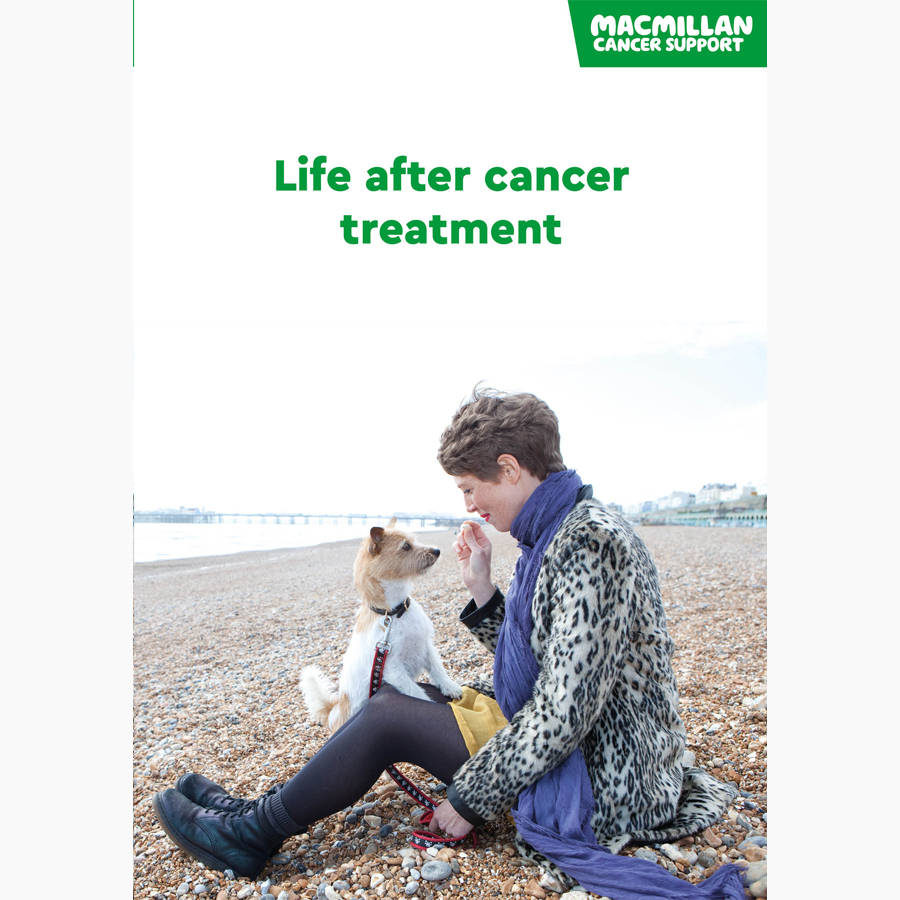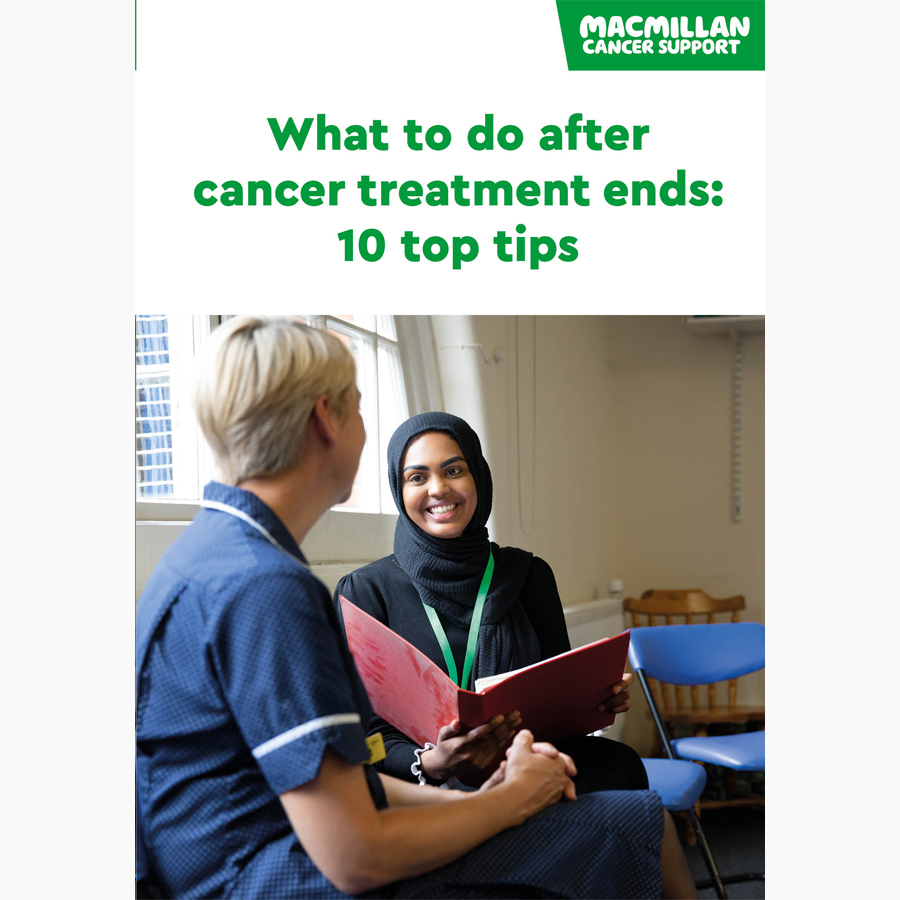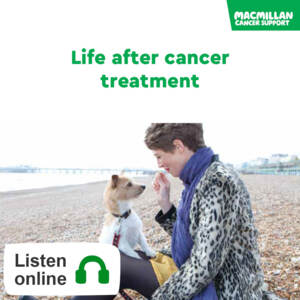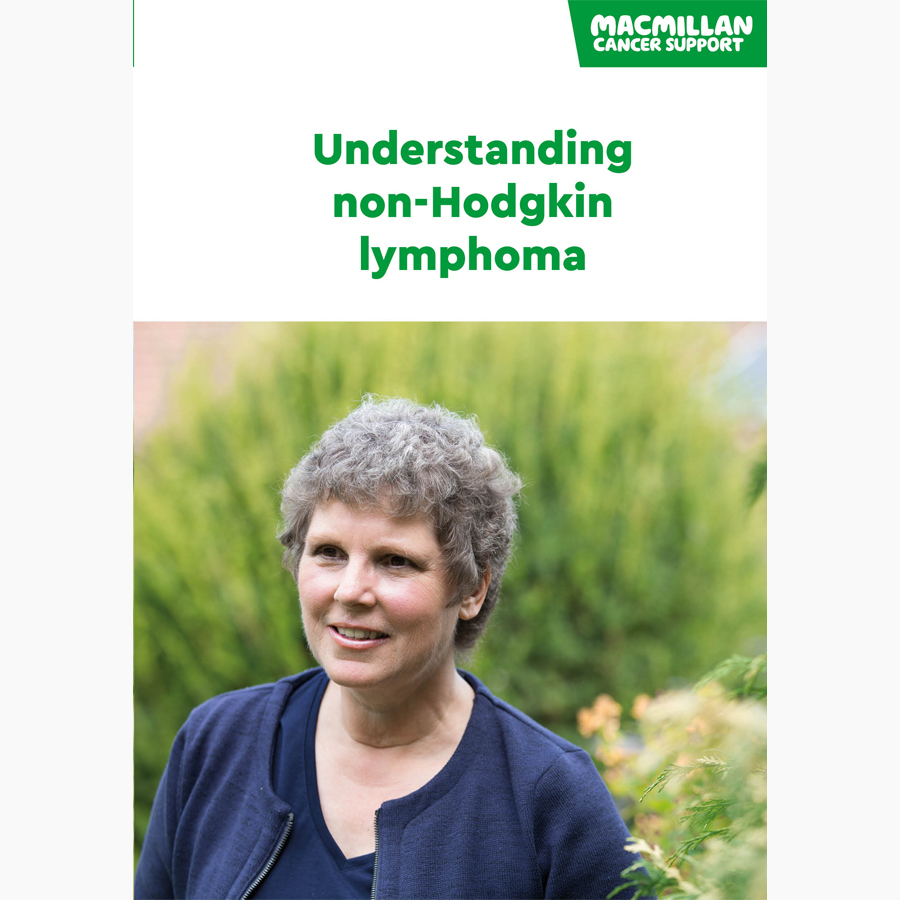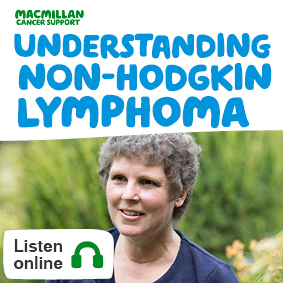Diffuse large B-cell lymphoma (DLBCL)
Diffuse large B-cell lymphoma (DLBCL) is a common type of non-Hodgkin lymphoma.
On this page
-
What is diffuse large B-cell lymphoma (DLBCL)?
-
Symptoms of diffuse large B-cell lymphoma (DLBCL)
-
Causes of diffuse large B-cell lymphoma (DLBCL)
-
Diagnosis of diffuse large B-cell lymphoma (DLBCL)
-
The stages and grades of diffuse large B-cell lymphoma (DLBCL)
-
Treatment for diffuse large B-cell lymphoma (DLBCL)
-
After treatment for diffuse large B-cell lymphoma (DLBCL)
-
Access our lymphoma information in other formats
-
About our information
-
How we can help
What is diffuse large B-cell lymphoma (DLBCL)?
Diffuse large B-cell lymphoma (DLBCL) is a common type of non-Hodgkin lymphoma.DLBCL develops when B-cells become abnormal (cancerous). B-cells are white blood cells that normally help fight infection. They are sometimes called B-lymphocytes.
The abnormal B-cells (lymphoma cells) usually build up in lymph nodes, but they can affect other parts of the body.
DLBCL can affect people of all ages, but it is more common around the age of 70. It is slightly more common in men than in women.
DLBCL develops quickly. You will usually start treatment soon after your diagnosis.
Related pages
For healthcare professionals
If you are a healthcare professional, use our guide to find the right information and support for your patients affected by lymphoma. This explains the support available from Macmillan and from other trusted organisations.
Symptoms of diffuse large B-cell lymphoma (DLBCL)
Painless swelling in the neck, armpit or groin
Painless swelling in the neck, armpit or groin is often the first sign of DLBCL. It is caused by lymphoma cells building up in the lymph nodes, which makes them bigger. Often lymph nodes in more than one part of the body are affected.
B symptoms
Some people also have symptoms that doctors call B symptoms. These can include:
- drenching night sweats which require a change of nightwear and bed covers
- high temperatures (fevers) with no obvious cause
- unexplained weight loss.
Knowing if you have any B symptoms will help your doctor to stage the lymphoma and plan your treatment.
Other symptoms
DLBCL may also affect other parts of the body outside the lymph nodes, such as the stomach or bowel. This is called extranodal disease. Symptoms depend on the area affected.
General symptoms of DLBCL may include loss of appetite and tiredness.
Related pages
Causes of diffuse large B-cell lymphoma (DLBCL)
The causes of diffuse large B-cell lymphoma (DLBCL) are mostly unknown. But some things may increase your risk of developing it.
-
Weak immune system
Your risk of developing DLBCL may be higher if your immune system is weak. Your immune system can be weakened by
- conditions such as HIV infection
- drugs called immunosuppressants – these are wised after an organ transplant, or to treat autoimmune disease.
-
Autoimmune diseases
Some autoimmune diseases such as rheumatoid arthritis may increase your risk of DLBCL. Autoimmune diseases develop when the immune system attacks healthy body tissue by mistake. Doctors do not fully understand why these diseases increase the risk of developing lymphomas. It may be because of the diseases themselves, or because of the treatments used to control them.
-
Having a parent or sibling with DLBCL
Having a parent, brother or sister with DLBCL may slightly increase your risk of developing it. We do not know why this is. It may be because there is a genetic problem shared by families. Or it may be because people in a family often have similar lifestyles.
Like other cancers, DLBCL is not infectious. It cannot be passed on to other people.
We have more about causes and risk factors in our information about non-Hodgkin lymphoma.
Diagnosis of diffuse large B-cell lymphoma (DLBCL)
Biopsy for lymphoma
The most common test for diagnosing lymphoma is a biopsy. A doctor will take a sample of tissue from the affected area. The most common place to take a biopsy from is an enlarged lymph node. This is called a lymph node biopsy). You may have all or a part of the lymph node removed. The tissue will be sent to a laboratory for testing. You may also have biopsies taken from other areas of your body.
You can read more about further tests you may have in our information about non-Hodgkin lymphoma.
Waiting for test results can be a difficult. You may find it helpful to talk to your family, friends or specialist nurse.
Related pages
Booklets and resources
The stages and grades of diffuse large B-cell lymphoma (DLBCL)
Your test results will help your doctors find out how many areas of your body are affected by lymphoma and where these areas are. This is called staging.
Knowing the stage of the lymphoma helps your doctor plan the right treatment for you.
Lymphomas are grouped as either low-grade or high-grade. Low-grade lymphomas are usually slow growing. High-grade lymphomas usually grow more quickly. Diffuse large B-cell lymphoma (DLBCL) is a high-grade, fast growing lymphoma.
We have more information about the stages of non-Hodgkin lymphoma.
Treatment for diffuse large B-cell lymphoma (DLBCL)
A team of specialists will meet to discuss the best possible treatment for you. They are called a multidisciplinary team (MDT).
Your doctor, cancer specialist or nurse will explain the different treatments and their side effects to you. They will also talk to you about things to consider when making treatment decisions.
You may have some treatments as part of a clinical trial.
These are the most common treatments for DLBCL.
-
Immunotherapy and chemotherapy
DLBCL is usually treated with a combination of the immunotherapy drug rituximab, chemotherapy and other drugs. This is called chemoimmunotherapy.
A commonly used combination is called R-CHOP. Other combinations are sometimes used, such as:
- R-GCVP - rituximab, gemcitabine, cyclophosphamide, vincristine and prednisolone (a steroid)
- R-CODOXM
- R-IVAC.
We have more information on chemotherapy and immunotherapies for lymphoma.
-
Intrathecal chemotherapy
A small number of people are at risk of having lymphoma in their brain or spinal cord. Chemotherapy can be given directly into the spinal fluid to treat lymphoma or to reduce the risk of lymphoma developing in these areas. This is called intrathecal chemotherapy.
-
Steroids
Steroids are drugs that are often given with chemotherapy to treat lymphomas. They help make chemotherapy more effective.
-
Radiotherapy
Radiotherapy uses high-energy rays to destroy cancer cells, while doing as little harm as possible to nearby healthy cells. Radiotherapy only treats the area of the body that the rays are aimed at. Some people have radiotherapy before or after chemotherapy to treat an area of lymphoma. Radiotherapy after chemotherapy can treat any remaining lymphoma cells in the area. It can also reduce the risk of lymphoma coming back in the area. Radiotherapy is also sometimes given to treat symptoms, such as pain.
-
Stem cell transplants
You may have a stem cell transplant to treat relapsed DLBCL. A stem cell transplant is an intensive treatment, so it is not suitable for everyone. You may have a transplant using:
- your own stem cells (autologous stem cell transplant)
- cells from a donor (allogeneic stem cell transplant).
-
CAR-T cell therapy
CAR-T cell therapy (chimeric antigen receptor therapy) involves collecting your own immune cells, reprogramming them, and then using them as a treatment to target the lymphoma cells. It can be used when the lymphoma is advanced and when other treatments have failed. CAR-T therapy is complicated and can have serious side effects. It is only suitable for a very small number of people. Currently, it is only available in a few specialist hospitals.
We have more information about treating lymphoma that has come back.
After treatment for diffuse large B-cell lymphoma (DLBCL)
People often have many different feelings when they finish lymphoma treatment. You may feel relieved that treatment has finished, but worried about what will happen in the future.
You will have appointments with your lymphoma doctor or nurse less often than before. But at the same time, you may have new challenges to cope with and things to think about.
We have information below about some of the things people ask about after lymphoma treatment. But you may have other questions or need information about something else. If there is something you want to talk about at any point after treatment, you can:
- call the Macmillan Support Line free on 0808 808 00 00
- chat to our specialists online
- visit our Online Community to talk to people who have been affected by lymphoma, share your experience, and ask an expert your questions.
Related pages
Other organisations who offer information and support
The organisations below also offer information and support:
-
Blood Cancer UK
Blood Cancer UK offers support and information to people affected by blood cancers, including lymphoma.
-
Lymphoma Action
Lymphoma Action provides high quality information and support for people affected by lymphoma. It provides helpline services and a range of peer support including online support meetings, educational events and webinars. Its website includes TrialsLink, a database of lymphoma clinical trials.
Lymphoma follow-up
Related pages
Side effects of lymphoma treatment
You may have some ongoing side effects as you recover from lymphoma treatment. You can use our impacts of cancer A-Z to search for information about managing different symptoms and side effects. Or find out more about side effects of treatment for Hodgkin lymphoma or treatment for non-Hodgkin lymphoma.
-
Tiredness and fatigue
Tiredness (fatigue) often affects people with cancer. It can be caused by lymphoma or be a side effect of lymphoma treatment. RESTORE is an online resource that aims to help people living with cancer related fatigue.
-
Sexual well-being
Lymphoma and its treatment can sometimes affect your sex life. There are ways to improve your sexual well-being and to manage any problems.
-
Fertility
Treatment for lymphoma may affect your fertility. If you are worried about your fertility it is important to talk with your doctor before you start treatment. We have more information about:
Sometimes side effects may continue or develop months or years after treatment. These are called late effects. We have more information about long-term and late effects of treatment for lymphoma.
Well-being and recovery
It can take time to recover after lymphoma treatment. Some days you may feel better than others.
It is important to know where to get support or information if you need it. People often need support even some time after lymphoma treatment. But sometimes it is difficult to know who to ask for help. To find support:
- ask your GP or someone from your cancer team for advice about support in your area
- search cancercaremap.org to find cancer support services near you
- call us free on 0808 808 0000 or talk to us online - our cancer information and support specialists can offer guidance and help you find what you need.
Our course Help to Overcome Problems Effectively (HOPE) helps people during and after cancer treatment. It is a free, interactive, group based, self management support course. It runs for 6 weeks, with each weekly session lasting 2.5 hours. To find out more about HOPE courses in your area, email ServiceOpsSupport@macmillan.org.uk
A healthy lifestyle can help speed up your recovery. Even small lifestyle changes may improve your well-being and long-term health.
Related pages
Booklets and resources
Other useful information
Access our lymphoma information in other formats
We are working to make our website as accessible as possible. We want everyone to be able to use it to find the information they need. We have tips about using settings on your computer or device to help you use our website in our accessibility statement.
We also provide information in a range of languages and formats. If you cannot find the information you are looking for in the format or language you need, email us at cancerinformationteam@macmillan.org.uk
Order our non-Hodgkin lymphoma booklet
Download our lymphoma booklet and ebooks
Our Understanding non-Hodgkin lymphoma booklet is available as a pdf to download or view online and in ePub or Mobi formats to download.
Booklets and resources
Listen to our lymphoma audiobook
You can listen to our Understanding non-Hodgkin lymphoma audiobook. You can also search our full range of audiobooks.
Booklets and resources
Find non-Hodgkin lymphoma information in your language
We have a range of translated cancer information. This includes information about different cancer types, being diagnosed, cancer treatment, and side effects. We have some lymphoma information in the following languages. You can also search our most up to date list of web pages we have translated on request.
- Bulgarian - Mantle cell lymphoma / Мантелноклетъчен лимфом [PDF]
- German - Follicular lymphoma / Follikuläres Lymphom (FL) [PDF]
- Polish - Diffuse large B-cell lymphoma (DLBCL) / Chłoniak rozlany z dużych komórek B [PDF]
- Polish - Lymphoma / Chłoniak [PDF]
- Slovak - Anaplastic large cell lymphoma (ALCL) / Anaplastický veľkobunkový lymfóm [PDF]
- Slovak - Follicular lymphoma / Folikulový lymfóm [PDF]
- Tamil - Follicular lymphoma [PDF]
If you would like any of our lymphoma information translated into your language, please email cancerinformationteam@macmillan.org.uk
Watch British sign language videos
You can watch our BSL videos about cancer on YouTube.
Find our easy read booklets
Our easy read booklets use simple words and pictures to tell you about cancer. They can be useful if you want information that is easier to understand.
Looking for large print, Braille or another format?
If you would like our information in a different format such as large print or Braille, email us at cancerinformationteam@macmillan.org.uk or call us free on 0808 808 00 00.
About our information
-
References
Below is a sample of the sources used in our diffuse large B-cell lymphoma (DLBCL) information. If you would like more information about the sources we use, please contact us at cancerinformationteam@macmillan.org.uk
Tilly H, Gomes da Silva M, et al on behalf of the ESMO Guidelines Committee. Diffuse large B-cell lymphoma (DLBCL): ESMO Clinical Practice Guidelines for diagnosis, treatment and follow-up. Annals of Oncology. 2015. Sept:26 (Supplement 5), v116-125. Available from www.annalsofoncology.org/article/S0923-7534(19)47184-6/pdf
Vitolo U, Seymour JF, et al. Extranodal diffuse large B-cell lymphoma and primary mediastinal B-cell lymphoma: ESMO Clinical Practice Guidelines. Annals of Oncology. 2016. 27 (Supplement 5), v91-v102. Available from: www.annalsofoncology.org/article/S0923-7534(19)31640-0/pdf
-
Reviewers
This information has been written, revised and edited by Macmillan Cancer Support’s Cancer Information Development team. It has been reviewed by expert medical and health professionals and people living with cancer. It has been approved by Senior Medical Editor, Dr Anne Parker, Consultant Haematologist.
Our cancer information has been awarded the PIF TICK. Created by the Patient Information Forum, this quality mark shows we meet PIF’s 10 criteria for trustworthy health information.
Date reviewed
This content is currently being reviewed. New information will be coming soon.

Our cancer information meets the PIF TICK quality mark.
This means it is easy to use, up-to-date and based on the latest evidence. Learn more about how we produce our information.
How we can help




